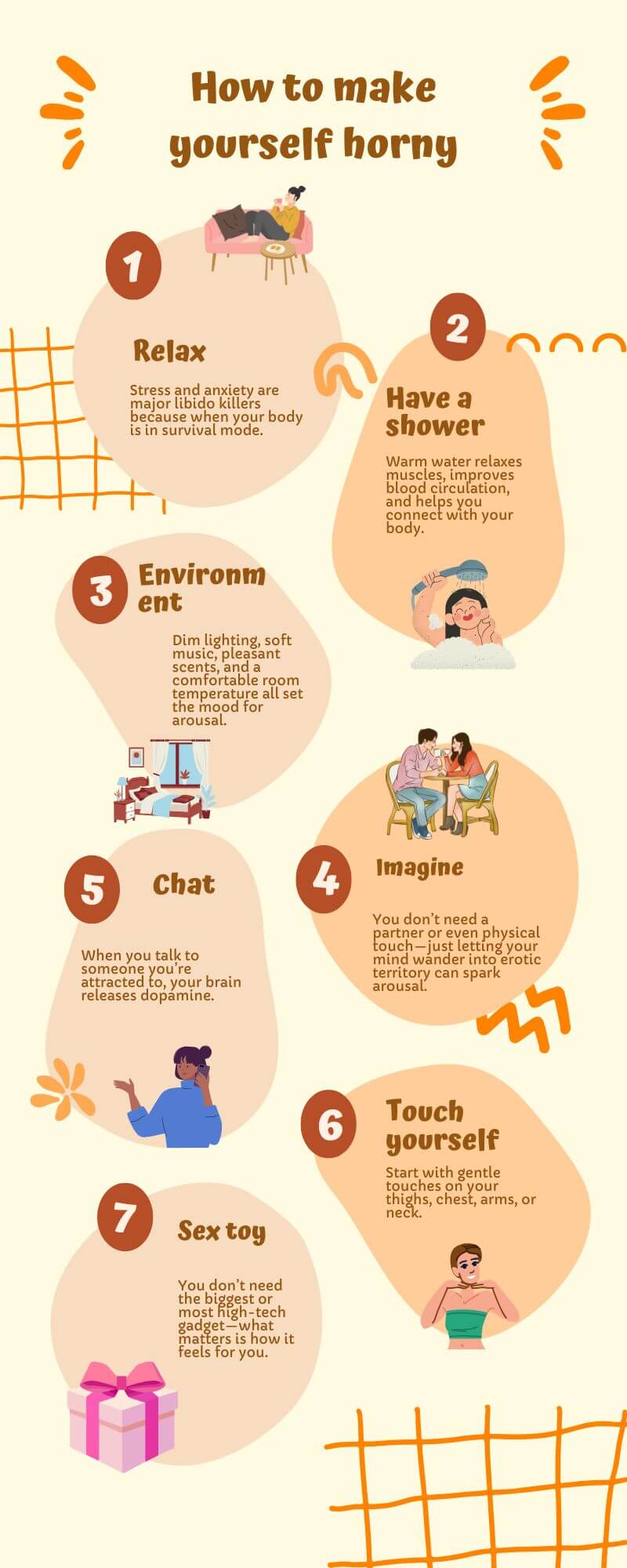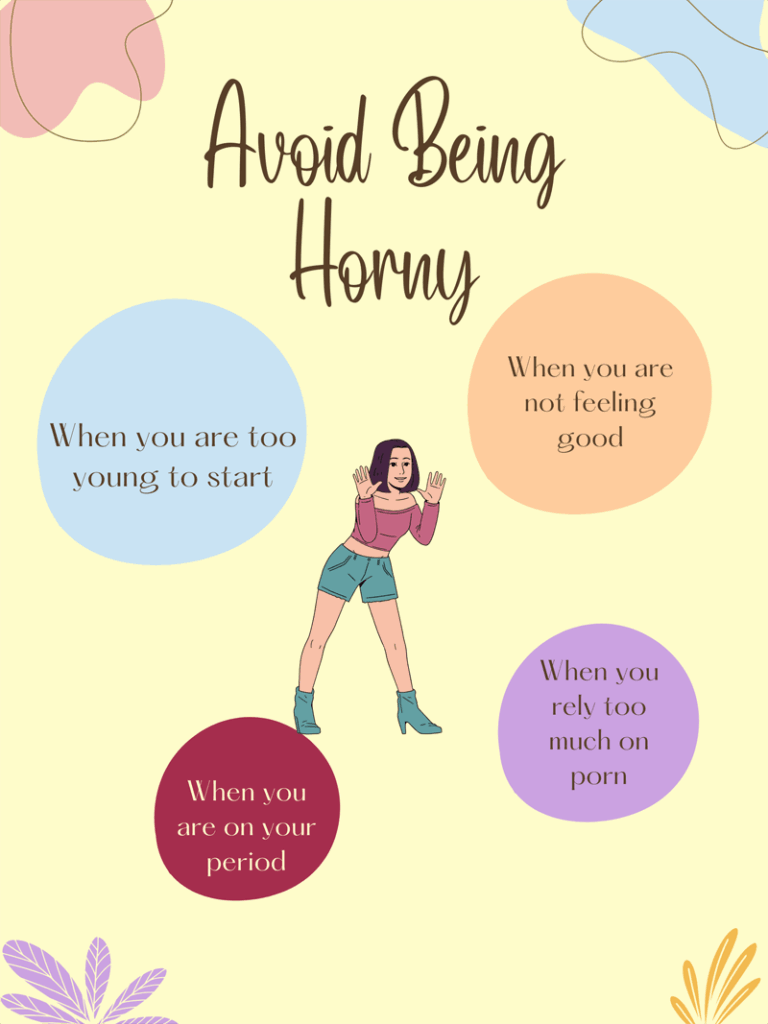Let’s be real—sometimes you just don’t feel it. Your sex drive might dip because of stress, fatigue, lack of experience, or even things like anxiety and hormonal changes. But here’s the good news: being “horny” isn’t some magical state that only happens randomly. It’s something you can invite, encourage, and nurture.
In this guide, we’ll walk through practical, science-backed (and fun) ways to get yourself in the mood. From relaxing your mind to adjusting your environment, sparking erotic thoughts, or exploring with toys, you’ll find that getting turned on can be as much about your headspace as it is about your body.
Whether you’re curious, struggling with low libido, or just want to spice things up, this article will give you easy practices, helpful tips, and a few things to avoid. By the end, you’ll see that arousal isn’t just about waiting—it’s about creating the right conditions to let your desire grow.
Why we need to be horny?
Sexual desire isn’t just about pleasure—it’s a key part of our overall well-being. When your libido is healthy, it boosts intimacy, helps reduce stress, and even improves mood. But sometimes, things get in the way:
- Libido fading – Stress, overwork, or lack of sleep can easily dull your sex drive.
- Lack of sex experience – If you haven’t explored much, it can be harder to “switch on” your arousal.
- Anorgasmia – Some people struggle to reach orgasm, which can make them feel disconnected from their sexual self.
Being horny isn’t about being “naughty”—it’s about reconnecting with your body and giving yourself permission to enjoy. Learning how to trigger arousal can help you feel more alive, confident, and sexually satisfied.
General practices to get horny
Getting yourself aroused isn’t always about jumping straight into action—it often starts with setting the right conditions. Your body and mind need to feel safe, comfortable, and open to pleasure. By building the right mood and practicing simple habits, you can make it much easier for desire to show up naturally.

Relax
One of the simplest (yet most powerful) ways to get horny is to relax. Stress and anxiety are major libido killers because when your body is in survival mode, it produces cortisol, a hormone that dampens sexual desire. When you relax, though, your body can release dopamine and oxytocin—neurochemicals that are linked to arousal and bonding.
Research supports this connection. Brotto and Basson (2014) found that mindfulness and relaxation techniques significantly improved sexual desire and arousal in women with low libido. In another study, a curvilinear relationship between state anxiety and physiological sexual arousal were found (Andrea et al., 2005).
So, before anything else, give yourself permission to unwind. Take deep breaths, try a short meditation, stretch, or even just lie down in a quiet space. Once your mind feels calmer, your body is much more likely to follow with feelings of arousal.
Have a shower
Sometimes, the fastest way to wake up your senses is simply stepping into the shower. Warm water relaxes muscles, improves blood circulation, and helps you connect with your body. The soothing effect can lower stress levels and make you more receptive to arousal.
Research suggests that hydrotherapy and warm baths improve relaxation and mood, both of which are linked to sexual desire (Mourot et al., 2008). Plus, showers give you a chance for sensual self-touch—running your hands over your skin with soap or a gentle sponge can turn into a playful warm-up.
Tip: Try alternating between warm and cooler water. The temperature shifts can heighten body awareness and increase sensitivity.
Adjust the environment: light, sound, smell, and temperature
Your environment plays a huge role in how easily you can get turned on. Dim lighting, soft music, pleasant scents, and a comfortable room temperature all set the mood for arousal. Sexual desire often thrives in spaces where you feel safe, relaxed, and stimulated in subtle ways.
Research shows that sensory cues such as lighting and scent can directly affect mood and sexual response. For example, Herz (2009) found that certain smells (like vanilla or lavender) can trigger positive emotional and physiological responses, while music has long been linked to heightened sexual arousal (Mitchell et al., 2005).
So, think of your space as a stage: light a candle, play your favorite slow playlist, and make sure the room feels cozy. The right vibe can make all the difference.
Imagine something erotic
Fantasy is one of the brain’s strongest tools for turning on desire. You don’t need a partner or even physical touch—just letting your mind wander into erotic territory can spark arousal. Fantasies activate the same brain regions that are involved in real sexual experiences, making them surprisingly effective.
Studies have shown that sexual imagery increases genital blood flow and self-reported arousal (Janssen et al., 2000). In short, your imagination can trick your body into feeling horny.
Tip: Start by picturing a sexy memory or build a fantasy scene in your head. The more detail you imagine, the stronger the arousal can become.
Chat with the person you like
Flirty conversations can be a direct path to turning yourself on. When you talk to someone you’re attracted to, your brain releases dopamine—the same feel-good chemical linked to excitement and desire. Even simple text messages or playful banter can spark sexual thoughts.
Research confirms that social connection and intimacy boost sexual motivation. A study by Birnbaum and Reis (2012) found that emotional closeness and positive interactions with partners were strong predictors of sexual desire.
So, don’t underestimate the power of a casual chat. Sending a fun, cheeky text or spending time in conversation can naturally get you in the mood.
Touch yourself
Arousal often grows from physical stimulation, but you don’t need to go straight to the most sensitive areas. Start with gentle touches on your thighs, chest, arms, or neck. Exploring your body slowly helps you tune into sensations and build anticipation.
Research has shown that self-touch and masturbation are healthy ways to explore desire and improve sexual satisfaction (Levin, 2007). Starting slow gives your brain time to connect with your body, making the eventual arousal stronger.
Tip: Use light strokes, circular motions, or even a massage oil to make it more sensual. Think of it as teasing yourself into getting horny.
Use a sex toy
Sex toys can be an amazing shortcut to arousal. Vibrators, dildos, or even beginner-friendly tools like bullet vibes stimulate nerve endings in ways that hands sometimes can’t. They add novelty, variety, and intensity to self-play, which can boost excitement quickly.
According to a research, Herbenick et al. (2009) found that vibrator use was strongly associated with greater sexual pleasure, arousal, and satisfaction in both men and women. Toys aren’t just for orgasms—they can help kickstart desire when you’re struggling to feel horny.
Tip: If you’re new, start with something small and simple. You don’t need the biggest or most high-tech gadget—what matters is how it feels for you.
Not recommend if:
Not every situation is the right time to push yourself to feel horny. Sometimes, it’s better to step back and let your body rest instead of forcing arousal. Here are a few moments when you should not try to make yourself horny:

You are too young to start
Sexual exploration is a natural part of adulthood, but if you’re underage, it’s best to wait. Your body and brain are still developing, and starting too early may create confusion or unhealthy habits. Research shows that early exposure to sexual behaviors or explicit material is linked to higher risks of anxiety and risky sexual behavior later (Owens et al., 2012).
You are not feeling good
If you’re sick, overly stressed, or emotionally drained, your body might not respond well to arousal. Forcing it can leave you more frustrated than satisfied. Studies have shown that stress, depression, and fatigue are strongly linked to lower sexual desire and arousal (Laumann et al., 1999). In this case, focus on rest and recovery—your sex drive will come back when you feel better.
You are on your period
For some people, menstruation lowers sexual desire due to cramps, bloating, or discomfort. While others may enjoy period sex, if you’re not feeling up to it, don’t pressure yourself. Hormonal shifts during the cycle can affect libido differently for each person (Bullivant et al., 2004). The key is listening to your body—if it says “not now,” respect that.
You rely too much on porn
Porn can feel like a quick fix to get horny, but over-reliance may backfire in the long run. Watching porn frequently can desensitize your brain, making it harder to get aroused by real-life intimacy. Studies suggest that excessive porn use is linked to reduced sexual satisfaction and difficulties with arousal (Kraus et al., 2016).
It’s fine to enjoy porn sometimes, but try not to depend on it as your only source of arousal. Mixing in imagination, touch, or sex toys can help keep your sex drive healthier and more balanced.
FAQ
How to make yourself less horny?
Sometimes you need to cool it down. Try exercise, a cold shower, or distracting yourself with work, hobbies, or even a funny movie. Horniness often fades when your brain is focused elsewhere.
How to use a balloon to make yourself horny?
Some people enjoy the sound, feel, or play of balloons (called “looners”). If it excites you, that’s okay—as long as it’s safe and consensual. Just don’t swallow balloon pieces or use them in risky ways.
How to make yourself horny for anal?
Go slow. Arousal for anal play often builds with relaxation, lots of lube, and plenty of teasing. Start with external touches before moving inward. Remember: the more relaxed you are, the better it feels.
How to make yourself horny as a man?
Men can use the same tricks as anyone else: relax, touch themselves, use toys, or tap into fantasy. Flirty chats, erotic media, or even a workout to boost testosterone can also kick things up a notch.
How to make yourself hornier without porn?
Use your imagination, focus on touch, or create the right atmosphere. Sensual music, reading erotica, or using toys can help you build arousal without relying on porn.
How to make yourself cum?
Explore what feels good for you—stimulation, toys, fantasy, or changing positions. Build up slowly, enjoy the sensations, and don’t pressure yourself. Orgasms are easier when you’re relaxed and in the moment.
To wrap up
Getting horny isn’t always automatic—and that’s okay. With a little effort, you can create the right environment, mindset, and practices to bring your desire back. From relaxing and showering to touching yourself or using toys, the journey is all about learning what your body responds to best.
And remember: there’s no “right” way to be horny. Some days your sex drive will be high, other days not so much. The important thing is listening to yourself, having fun with the process, and letting arousal grow naturally.
References
1. Brotto, L. A., & Basson, R. (2014). Group mindfulness-based therapy significantly improves sexual desire in women. Behaviour research and therapy, 57, 43–54. https://doi.org/10.1016/j.brat.2014.04.001
2. Bradford, A., & Meston, C. M. (2006). The impact of anxiety on sexual arousal in women. Behaviour research and therapy, 44(8), 1067–1077. https://doi.org/10.1016/j.brat.2005.08.006
3. Mourot, L., Bouhaddi, M., Gandelin, E., Cappelle, S., Dumoulin, G., Wolf, J. P., Rouillon, J. D., & Regnard, J. (2008). Cardiovascular autonomic control during short-term thermoneutral and cool head-out immersion. Aviation, space, and environmental medicine, 79(1), 14–20. https://doi.org/10.3357/asem.2147.2008
4. Herz R. S. (2009). Aromatherapy facts and fictions: a scientific analysis of olfactory effects on mood, physiology and behavior. The International journal of neuroscience, 119(2), 263–290. https://doi.org/10.1080/00207450802333953
5. Mitchell, L. A., MacDonald, R. A., & Brodie, E. E. (2005). A Comparison of the Effects of Preferred Music, Arithmetic and Humour on Cold Pressor Pain. European Journal of Pain, 10 (4), 343-51. Retrieved from https://remix.berklee.edu/mhi-citations/397
6. Janssen, E., Everaerd, W., Spiering, M., & Janssen, J. (2000). Automatic processes and the appraisal of sexual stimuli: Toward an information processing model of sexual arousal. Journal of Sex Research, 37(1), 8–23. https://doi.org/10.1080/00224490009552016
7. Birnbaum, G. E., & Reis, H. T. (2012). When Does Responsiveness Pique Sexual Interest? Attachment and Sexual Desire in Initial Acquaintanceships. Personality and Social Psychology Bulletin, 38(7), 946-958. https://doi.org/10.1177/0146167212441028
8. Levin, R. J. (2007). Sexual activity, health and well-being–the beneficial roles of coitus and masturbation. Sexual and Relationship Therapy, 22(1), 135–148. https://doi.org/10.1080/14681990601149197
9. Herbenick, D., Reece, M., Sanders, S., Dodge, B., Ghassemi, A., & Fortenberry, J. D. (2009). Prevalence and characteristics of vibrator use by women in the United States: results from a nationally representative study. The journal of sexual medicine, 6(7), 1857–1866. https://doi.org/10.1111/j.1743-6109.2009.01318.x
10. Owens, E. W., Behun, R. J., Manning, J. C., & Reid, R. C. (2012). The impact of internet pornography on adolescents: A review of the research. Sexual Addiction & Compulsivity: The Journal of Treatment & Prevention, 19(1-2), 99–122. https://doi.org/10.1080/10720162.2012.660431
11. Laumann, E. O., Paik, A., & Rosen, R. C. (1999). Sexual dysfunction in the United States: prevalence and predictors. JAMA, 281(6), 537–544. https://doi.org/10.1001/jama.281.6.537
12. Bullivant, S. B., Sellergren, S. A., Stern, K., Spencer, N. A., Jacob, S., Mennella, J. A., & McClintock, M. K. (2004). Women’s sexual experience during the menstrual cycle: identification of the sexual phase by noninvasive measurement of luteinizing hormone. Journal of sex research, 41(1), 82–93. https://doi.org/10.1080/00224490409552216
13. Kraus, S. W., Martino, S., & Potenza, M. N. (2016). Clinical Characteristics of Men Interested in Seeking Treatment for Use of Pornography. Journal of behavioral addictions, 5(2), 169–178. https://doi.org/10.1556/2006.5.2016.036


